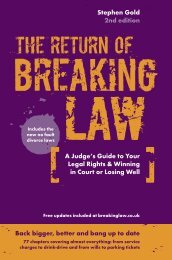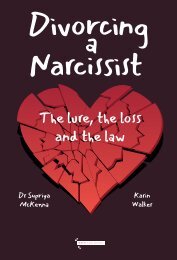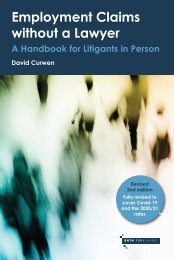Insolvency Made Clear: A Guide for Debtors
Plain English, practical guidance for anyone facing demands over a debt they are struggling to pay.
Plain English, practical guidance for anyone facing demands over a debt they are struggling to pay.
Create successful ePaper yourself
Turn your PDF publications into a flip-book with our unique Google optimized e-Paper software.
Effect Of Bankruptcy<br />
the seller goes to the first car dealership they know about. Transactions at<br />
an undervalue are usually only identified in extreme cases, where the best<br />
explanation <strong>for</strong> why the item was sold at that value is the desire <strong>for</strong> the<br />
purchaser to make a profit at the expense of the soon-to-be bankrupt. This<br />
desire is not a requirement of a s339 transaction.<br />
2. Preferences: s340 of the Act. Where a bankrupt has ‘at a relevant time’<br />
given a preference to any person, the Trustee can apply <strong>for</strong> an order <strong>for</strong> the<br />
court to restore the position to what it would have been had the individual<br />
not given that preference. A ‘preference’ is given where one creditor (or a<br />
guarantor of the bankrupt’s debts) is deliberately put in the position where<br />
they are better off. It will be assumed that the preference was deliberately<br />
given if it was received by an ‘associate’ of the bankrupt. Outside of an associate,<br />
it is often difficult <strong>for</strong> a Trustee to show that a preference was given<br />
with the wrong intention. An example of a preference is when a bankrupt<br />
repays her parents’ loan in full. Even though the money was owed to the<br />
parents, the parents would be in a better position than had they received<br />
the same treatment as their daughter’s other unsecured creditors.<br />
‘Associate’ is defined in s435 of the Act, but it commonly refers to a relative or a<br />
spouse. It excludes best friends, perhaps because it would be difficult to demonstrate<br />
that two people were sufficiently friendly. This does not mean it is acceptable<br />
to grant a preference to a best friend – this could be a criminal offence if the<br />
intention was to defraud creditors – but only to note that it is more difficult <strong>for</strong><br />
the Trustee to undo the preference. An associate includes an employer or employee.<br />
A company is an associate of another person if that person has control<br />
of it, or if that person or their other associates together have control of it. Merely<br />
because someone is a ‘business associate’ of the bankrupt does not mean that<br />
they are an associate <strong>for</strong> the purposes of s435 of the Act, although the two might<br />
be associates through joint control of a company.<br />
Although a transaction at an undervalue does not need to be to an associate,<br />
in practice a Trustee will most likely suspect a transaction has been made at an<br />
undervalue when it was made to someone connected with the bankrupt in some<br />
way. It would be peculiar <strong>for</strong> a bankrupt to make a transaction at an undervalue<br />
with a stranger: there would be no reason not to obtain full value.<br />
The ‘relevant time’ is defined in three ways.<br />
• For a transaction at an undervalue, it is five years be<strong>for</strong>e the day when the<br />
bankruptcy petition was presented.<br />
• For a preference which is not a transaction at an undervalue but is given to<br />
an associate, it is two years ending with the presentation of the bankruptcy<br />
petition.<br />
21













